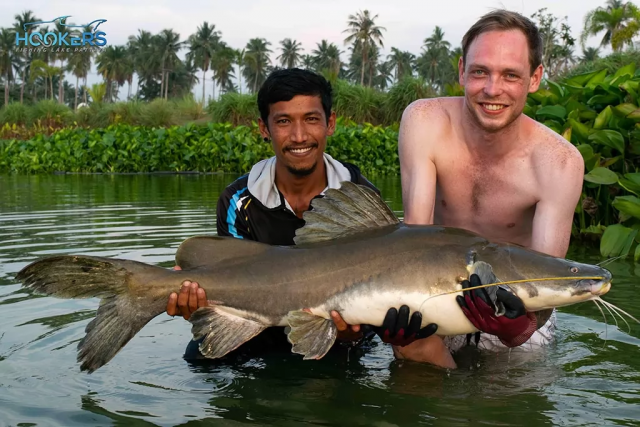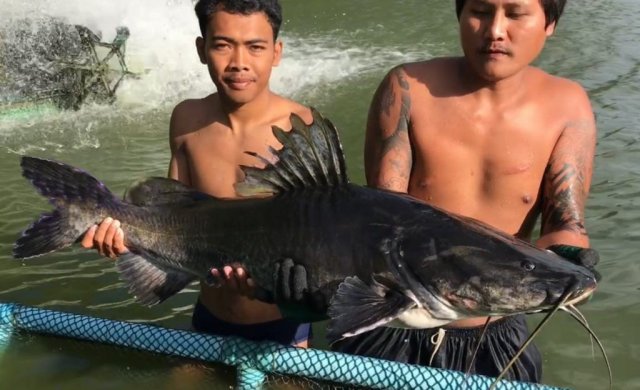I take maydelli back. Keep forgetting maydelli is an Indian fish and the folks holding the fish are not Indian. So microphthalmus remains possible as it also occurs in the Mekong.
These are not Sperata of any species. The head and snout are way too wide, the eyes too small, the adipose is too small, the dorsal is too short (though collapsed in the pics), etc. The head alone as well as the body and fin proportions are pretty specific to Hemibagrus.
Hemibagrus from our database:
These are not Sperata of any species. The head and snout are way too wide, the eyes too small, the adipose is too small, the dorsal is too short (though collapsed in the pics), etc. The head alone as well as the body and fin proportions are pretty specific to Hemibagrus.
Hemibagrus from our database:
| ARTC | Hemibagrus wyckioides.Greek,hemi=the_half+Mozarabic,bagre,Greek,pagros=a_fish,Dentex_sp. | Actinopterygii (ray-finned fishes) > Siluriformes (Catfish) > Bagridae (Bagrid catfishes) | Max 130 cm TL; common 50 cm SL; max 86 kg. FWR 120-185 cm; 32-100 kg; 16+ years. | Freshwat.; demersal; potamodromous | Subtropical | Asia: Mekong basin. Reported from Chao Phraya, Maeklong & Peninsular Thailand river systems. | Occurs in large upland rivers. Common in areas with rocky bottoms & irregular depths. Apparently does not migrate but reproduces locally & enters the flooded forest during high water in Jul-Oct. Feeds on insects, prawns, fish & crabs. Marketed fresh. Max 86 kg reported for a fish caught in Mae Klong River, Thailand (J-F. Helias, pers.comm., 07/2002). |
| Krishna Mystus | Hemibagrus maydelli | Actinopterygii>Siluriformes > Bagridae | 165 cm TL; 59 kg. FWR 100-165 cm; 19-59 kg. | Freshwat.; demersal | Tropical | Asia: middle reaches of the Krishna river drainage in southern India. | Inhabits rivers. In Nagarjunasagar reservoir, this species contributed to the commercial fishery to the extent of 1 to 3 t per annum during 1976-80. |
| Irrawaddy Mystus | Hemibagrus microphthalmus | Actinopterygii>Siluriformes > Bagridae (Bagrid catfishes) | Max 133 cm TL m./u.; max 80 kg. FWR 50-180 cm; 2-80 kg. | Freshwat.; brackish; demersal; potamodromous | Tropical | Asia: Manipur drainage in India, Irrawaddy & Sittang drainages in Myanmar and, Salween River of Thailand. Recorded from Mekong River system in southern Laos. | Occurs in deeper rocky areas & tree roots. Caught t/o the year. Enters flooded forest during the months of high water (Jul-Oct). Feeds on fish, shrimps & crabs. Fisheries: minor com. |
| Yellow catfish | Hemibagrus nemurus | Actinopterygii>Siluriformes > Bagridae (Bagrid catfishes) | Max 65 cm SL male/unsexed. FWR 64-80 cm; 3-7 kg. | Freshwat.; brackish; benthopel.; pH 7.0-8.2; dH 10-25; potamodromous | Tropical 22 - 25°C; 19°N-6°S | Asia: Mekong, Chao Phraya & Xe Bangfai basins; also from the Malay Peninsula, Sumatra, Java, Borneo. | Occurs in most habitat types, but most frequent in large muddy rivers, with slow current & soft bottom. Enters flooded forest. Feeds on exogenous insects, aquatic insect larvae, shrimps, other crustaceans & fishes. Moves into flooded forests to spawn & the young are usually first seen in Aug. Returns to rivers in Nov-Dec. A highly priced aquar. fish. Food fish high in nutritive values esp. omega-3 fatty acids (EPA, DHA). Fisheries: com.; a/c: com.; aquar.: com. |
| Crystal-eyed or forktail catfish | Hemibagrus wyckii | Actinopterygii>Siluriformes > Bagridae | Max 71 cm SL m./u. FWR 65-80+ cm; 3.5-6 kg. | Freshwat.; demersal; potamodromous | Tropical 22 - 25°C | Asia: Thailand to Indonesia | Lives in large rivers with fast flowing water over muddy substrate. Appears to be restricted in the middle reaches of rivers. Feeds on insects, prawns & fishes. Food fish. Fisheries: com. |










